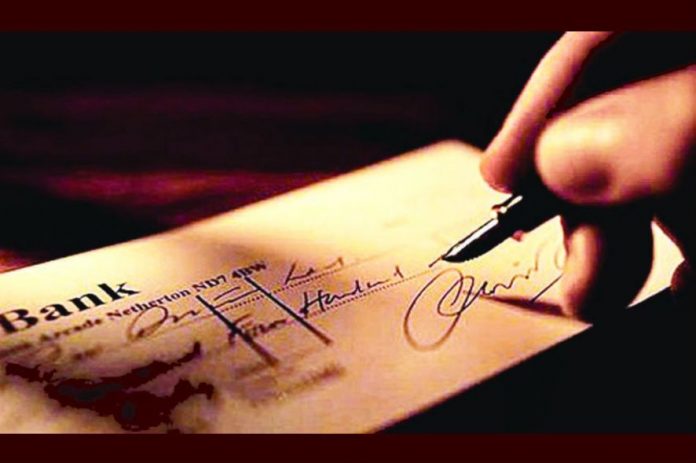This article is written by Beejal Ahuja from the New Law College, Bharati Vidyapeeth University, Pune. This article discusses a cheque bounce case under the Negotiable Instruments Act, and the defences available to the accused against such case.
Table of Contents
Introduction
Cheques are widely used payment methods nowadays, and the post-dated cheques are used in many transactions. When this mode of payment gained popularity, then at the same time, there were cases, in which the cheques were dishonoured or bounced and the payee was not receiving the cash for delivering services or goods. Then, a need was felt to criminalise this offence of cheque bouncing or dishonoured. So, in 1988, the criminalisation of the written cheques, with the insufficient balance in the drawer’s bank account, was introduced. An amendment was made in an old British Law, i.e., Negotiable Instruments Act, 1881, regarding the criminalisation of such an offence.
Overview of the Act
The Negotiable Instruments Act, 1881, deals with the negotiable instruments, which are a piece of paper representing a sum of money entitled to a person and can be transferred to another by the delivery of the same.
- Section 13 of this Act, states that a negotiable instrument means a promissory note, a bill of exchange or a cheque, payable to order, or to the bearer. So, an instrument is negotiable if it is defined under a statute or by usage like banknotes, bank drafts, share warrants, bearer debentures, divided warrants, scripts, and treasury bills.
- Section 4 of this Act defines promissory notes, as an instrument in writing, which contains an unconditional undertaking, signed by the maker to pay a sum of money to a certain person or the bearer of the instrument. And this instrument is not a banknote or a currency note. Drawee can be a person.
- Section 5 of this Act, defines a bill of exchange, also called as a draft, it is also an instrument in writing, which contains an unconditional order, signed by the maker, and directs a particular person to pay a certain amount of money to a certain person or the bearer of the instrument. Parties to a bill of exchange are a drawer, a drawee, and a payee. Drawee may be a person or a bank in case of a bill of exchange. This represents the indebtedness of a debtor towards a creditor.
- Section 6 of this Act, defines a cheque, as a bill of exchange drawn on a specified banker, and is not payable otherwise on demand. It is an order of a drawer or depositor on a bank. Parties to a cheque, are a drawer, a drawee, and a payee. Drawee can only be a particular bank. It has a certain validity i.e. for 3 months.
The penal provisions under this Act is from Section 138 to Section 142, i.e. they criminalise the offence of cheque bounce or cheque dishonour.
What is a Cheque Bounce
A cheque bounce is when the bank returns any cheques unpaid due to the insufficiency of funds in the account of the drawer and many other reasons. It is also called cheque dishonour. It is a dishonour of payment by the drawer to the drawee, due to some reasons. Legally, the drawer is the one who issues the cheque, and the one in whose favour the cheque is issued is the drawee.
Reasons for Cheque Bounce
When the cheque is bounced or dishonoured, then the bank issues a cheque return memo and also states the reasons for the cheque bounce. The following can be the possible reason for the cheque bounce:
- The signature of the drawer does not match.
- There is an overwriting on the cheque.
- The cheque was presented after the validity of three months, i.e. the cheque is expired.
- The account of the drawer is closed.
- Funds are insufficient in the account of the drawer.
- The payment has been stopped by the account holder itself.
- Insufficient opening balance.
- The words and figures mentioned on the cheque are inconsistent.
- If a cheque is issued by a company and there is no seal of that company.
- The account number does not match.
- If the account of the drawer is a joint one, then the signature of both the holders is required. And when only one holder signature is there, the cheque is bounced.
- The drawer or drawee has died.
- The drawer has become insolvent.
- The drawer has become insane.
- It is a crossed cheque.
- If the cheque is issued against the rules of the trust.
- If there have been alterations in the cheque.
- If the bank doubts the authenticity of the cheque.
- If the drawee has presented the wrong branch.
- If the cheque amount has crossed the limit of the overdraft.
Section 138 of the Negotiable Instruments Act
Section 138 of the Negotiable Instruments Act, 1881, states about the dishonour of cheque for insufficiency, etc, of funds in the account. When any person holding maintaining an account in any bank, issues a cheque to another person for the payment of a certain amount of money, out of that bank account for the discharge, wholly or partly, of any amount in debt or due to any other liability, which is returned by the bank unpaid either because of the reason that the amount of money standing in the credit in that bank account is insufficient to honour the cheque or if it exceeds the amount of money arranged to be paid from that bank account by an agreement made with the bank by the account holder.
Such person or that bank account holder shall be deemed to have committed an offence of cheque dishonour, and shall without prejudice to any other stated provisions of the Negotiable Instruments Act, and shall be punished with a maximum of imprisonment up to one year, or with a fine which may extend to twice the amount mentioned in the cheque, or both. An offence under this section is a bailable and non-cognizable offence.
Conditions for constituting the offence under Section 138
- The cheque issued by the drawer must have been presented to the bank within the valid period of the cheque, i.e. three months, from the day it was issued.
- If the bank has returned the cheque unpaid due to some reason, then firstly, the payee in the due course of the cheque, must have sent a notice in writing to the drawer demanding to make a payment for the said amount, within 30 days and along with also have sent the receipt of the information regarding the cheque bounce by the bank.
- Even after the notice, the drawer has not paid the said amount, within 15 days after sending the said notice.
So the above conditions must have been fulfilled to constitute an offence of cheque bounce under Section 138 of the Negotiable Instruments Act. This was stated by the court in the case of MSR Leathers v. S. Palaniappan, 2013.
Jurisdiction
- Section 142(2)(a) states that if the cheque is delivered for collection through an account, then the case for the offence of cheque bounce, will be tried by the court not lower to that of a Metropolitan Magistrate or a Judicial Magistrate of the first class, within whose the local jurisdiction, the branch of the bank, of the account of the holder concerned, is situated.
- Section 142(2)(b) states that if the cheque is presented for payment of payee or holder in due course otherwise through an account, then the case will be tried by the court no lower to that of a Metropolitan Magistrate or a Judicial Magistrate of the first class, within whose the local jurisdiction, the branch of the bank, of the account of the holder concerned, is situated.
Strategies to Defend a case under Section 138
These cannot always be in favour of the payee. There are many cases where cheques bounce in not because of the reasons mentioned above. Since the burden of proof is on the accused, there are defences available to the drawer, through which he/she can prove their innocence or plead not guilty, by proving how the debt mentioned is not legally enforceable.
Cheque bounced given as a security
If the accused or the drawer of the cheque, proves that the cheque issued, was not in discharge of any debt or liability, while issuing the cheque, and it was just given security deposit, hence it does not attract the offence under the Section 138, of the Negotiable Instruments Act.
Joseph Vilangadan v. Phenomenal Health Care Services
In this case, the appellants said that the given cheque was the refundable security deposit to ensure the performance of the work and the terms of the contract, and there was no existing debt or liability. Also, when the agreement was entered there was no debt or liability on the part of the drawer, and it was mentioned in the terms of the contract that if the contractor fails to perform his services then the respondent could encash and recover the amount. But the work was performed and hence, it did not come under the purview of Section 138 and so it’s not an offence.
Friendly loan concerning unaccounted money
Section 138 of the Negotiable Instruments Act, does not include within its purview the liability to pay an unaccounted cash amount. So, if there was a loan given which was in the form of an unaccounted cash, then it is not legally enforceable to repay it.
Sanjay Mishra v. Ms. Kanishka Kapoor
In this case, it was held by the Court that the applicant has failed to prove that the cheque issued by the respondent was in discharge of a legal liability of the loan amount, and also the respondent denied her signatures on the bill of exchange as well as the cheque and also the learned Judge, considered that the applicant admitted that the amount advanced was unaccounted and the same was not disclosed to the Income Tax Authority.
Accused disputing signature on the cheque
If the accused disputes signature on the cheque then only the banker could establish any reliable evidence that the cheque bounced due to the mismatching of the signature on the cheque. The bank manager has to show all the records related to the signature of the accused to testify that the signature on the cheque is not of the accused.
“Stop payment”, as instructed by the Drawer
If a complaint is made under Section 138 of the Negotiable Instruments Act, that the cheque was dishonoured because there were instructions by the drawer to stop the payment. So, in such cases the accused need to prove that there were sufficient funds in the account at the time when the payee went to the bank for encashing it, but the payment was stopped due to other reasons, then this will not constitute an offence under Section 138. The same was held in the case of MMTC Ltd. v. Medchi Chemicals and Pharma (P) Ltd., that if the accused shows that there were sufficient funds at the time of presentation of the cheque but the stop-payment notice was issued because of some valid reasons, then the offence under Section 138 is not made.
Section 139 of the Negotiable Instruments Act
The Section 139 states that it will be presumed unless the contrary is proved, that the payee received the cheque of the nature referred in Section 138 for the discharge, in wholly or partly, of any debt or any liability.
This presumption is no doubt rebuttable by the accused, by ‘preponderance of probabilities’. So, if the accused can establish a probable defence, that creates a reasonable doubt about the existence of a legally enforceable debt or liability, then the prosecution can fail. And the accused can do so by only using the materials or evidence presented by the prosecution, in many cases the accused did not need to present another or own evidence.
-
Virender Kumar v. Sumit
In this case, the accused was acquitted as he was able to rebut the presumption of legal liability. It was stated that by pointing out some loopholes in the story or the facts of the complainant, the accused can discharge his burden of proof and transfer it to the prosecution by demonstrating preponderance of probabilities.
There can be other defences as well, which depends on case to case. But yes, Section 140 of the Negotiable Instruments Act, clarifies that there is no such defence, that the drawer has no reason to believe, when the cheque was issued, that it would be bounced.
Conclusion
The Negotiable Instruments Act plays a role to prevent the misuse of the cheques and make sure that the transactions are done smoothly by penalising the offence of the cheque bounce. And also, the defences are available to the accused to avoid the fake cases of the cheque bounce or dishonour. But one needs to be very careful while dealing with cases of cheque bounce, as they involve many technicalities, and also they require very accurate proof of the transactions. It is not the same as other cases of offences.
References
LawSikho has created a telegram group for exchanging legal knowledge, referrals and various opportunities. You can click on this link and join:
 Serato DJ Crack 2025Serato DJ PRO Crack
Serato DJ Crack 2025Serato DJ PRO Crack









 Allow notifications
Allow notifications



